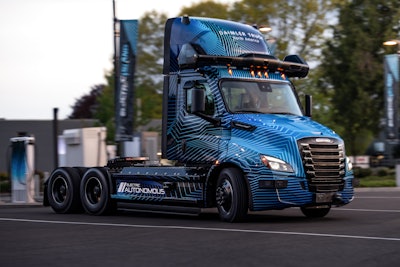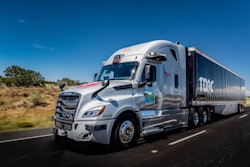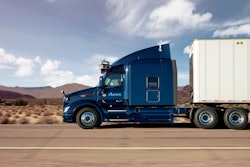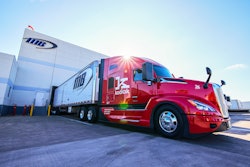
If electric trucks aren't enough leading-edge technology for you, Daimler Truck on Tuesday unveiled its next generation for the next generation: an autonomous electric truck.
Based on a production battery electric Freightliner eCascadia, the autonomous Freightliner eCascadia technology demonstrator is a first-of-its-kind vehicle equipped with Torc Robotic's autonomous driving software and its latest Level 4 sensor and compute technology. SAE Level 4 autonomous driving is defined as "highly automated" under limited circumstances.
The plan is for the truck to drive autonomously between freight centers along U.S. highway corridors, and by identifying synergies between zero emissions and autonomous infrastructure in a future scenario, Daimler Truck hopes the charging infrastructure and autonomous freight hubs could be combined to charge and load simultaneously.
"We're starting to think about those kinds of challenges today," said Head of Daimler Truck's Global Autonomous Technology Group Joanna Buttler, "so we'll have solutions ready tomorrow."
The truck itself is a research and advanced engineering project, but has the potential to evolve into a modular, scalable platform that is propulsion agnostic, said Buttler.
Alongside Daimler subsidiary Torc, Butler said the company is making progress toward introducing SAE Level 4 autonomous trucks in the U.S. by 2027, targeting autonomous trucks with conventional propulsion technology for first market launch. The autonomous eCascadia demonstrator provides a peek at future autonomous use cases, including shorter, repeatable routes – use cases that total 60 billion annual miles and more than 100 billion freight tons, Butler estimated – with the use of zero-emissions infrastructure, but depending on the application, future autonomous trucks could be powered by hydrogen-based systems.
DTNA has seen a more than 80% adoption rate of its base safety system, Butler said, and the eCascadia comes standard with the Detroit Assurance suite of safety systems, including Active Brake Assist 5. In the autonomous Freightliner eCascadia technology demonstrator, the autonomous sensor suite and computing power currently being tested on the autonomous diesel Cascadia, is packaged to fit the smaller day cab configuration of the battery electric eCascadia for the first time.
A prototype's prototype
 DNTA's engineering team developed an advanced air-cooling concept for the compute stack and positioned it between the driver and passenger seats to ensure adequate cooling.
DNTA's engineering team developed an advanced air-cooling concept for the compute stack and positioned it between the driver and passenger seats to ensure adequate cooling.
Four additional 12-volt batteries provide enough high voltage power to ensure uninterrupted operation of the autonomous system and increased efficiency and safety.
Freightliner's Inspiration Truck, almost exactly 9 years ago, became the first licensed SAE Level 2 autonomous commercial truck to operate on open public highways in the U.S. Torc started testing on public roads in Albuquerque in 2021, and Freightliner delivered the first-ever redundant Cascadia to Waymo the following year. The eCascadia technology demonstrator, Butler said, is the evolution of the self-driving technologies since the first generation rolled across the Hoover Dam in 2015, but it also integrates those technologies into a a zero emission strategy.
The battery electric Freightliner eCascadia, equipped with the Detroit ePowertrain (specifically two e-axles in this case), entered production in 2022 and, along with the electric eM2, has travelled 6 million miles with more than 55 fleets in the United States. Torc has tested autonomous-ready Freightliner Cascadia trucks in real-world applications with flet partners Schneider and C.R. England, successfully moving customer freight autonomously on its test route between Phoenix and Oklahoma City, over the past year.
Daimler Chief Engineer for Autonomous Driving Sumanoharan Narayanan said the learnings the company will port from its diesel trials over to the battery electric truck will help determine how the technologies need to be further refined for zero emissions platforms, including how an electric driveline will respond when compared to a diesel and automated manual transmission; how the technology stack would perform in low-mileage settings since many field trials to-date have included longer range transport; and how battery electric range will be impacted by a computer and suite of sensors that demand more power.













